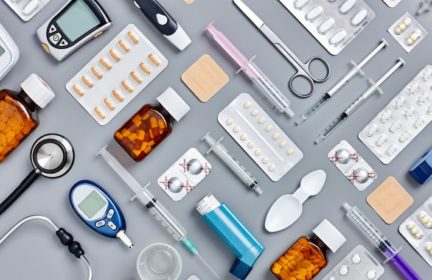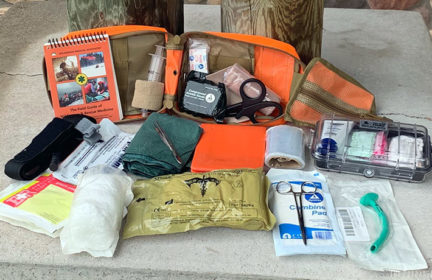Antibiotic resistance: Prepping for a world without effective antibiotics
My Background: I have an undergraduate degree in Biology and Society with a concentration in Infectious Disease Biology and I worked as a researcher in a microbiology lab focusing on Vibrio cholerae, the causative agent of cholera. I’m a fellow of the Cornell Institute for Host-Microbe Interactions and Disease. I am currently a COVID-19 contact tracer and part of the COVID-19 vaccine effort in my hometown. I will be beginning my PhD in the emerging infectious disease field in August.
This thread arose as a continuation of a post I made in the ‘How to prep for new and emerging diseases’ thread. Here is an excerpt from my original post about why antibiotic resistance is something we should be concerned about: “We must focus on what we can truly prepare for. A concern I have that should be on preppers radars is how bacteria pick up new genetic material (here’s a link explaining the process) which can confer antibiotic resistance to bacterial species. An estimated two million people are infected with antibiotic resistant infections annually in the United States alone. The World Health Organization has expressed concerns that the world is running out of effective antibiotics and this could present serious challenges to the standards of health we currently have in many countries. I stumbled upon an edition of The Economist’s July 2019 “The World If” series. Basically, it’s a fictional take on what happens if [insert event here]. This one focused on what would happen if we no longer had effective antibiotics. I stress that this is a link to FICTION (and everything else I’ve linked is to non-fiction), but it is chilling to read the authors take on what the world may look like with no access or severely reduced access to effective antibiotics. It definitely got me thinking about how and why to prep for a future without antibiotics.”
Legitimacy/Transparency: Most links are peer-reviewed publications from journals, universities, or from the World Health Organization, Centers for Disease Control and the United Nations. Feel free to not take my word for it and read the linked publications!
Reasons a Future Without Effective Antibiotics Is a Possibility: The problem is not so much a lack of supply of currently approved antibiotics, but the fact that current antibiotics are becoming obsolete due to overuse and we currently have a lack of incentives for companies to do research that brings new antimicrobials to market. Furthermore, the cost of bringing new antibiotics to market is a barrier and the profitability of antibiotics is lower than other drugs. Cancer drugs took precedence over bringing antibiotics to market, and this will likely come back to bite us: the United Nations antimicrobial resistance group estimates that 10 million drug-resistant related disease deaths will occur annually by 2050 if no action is taken to shift our current trajectory, which is “more than the number of people who currently die of cancer worldwide every year”. We have also stagnated on introducing new antibiotics to the market, as “the last entirely original class of antibiotic was discovered in the late 1980’s.” If this doesn’t shift soon it is not far-fetched to say we may end up in a world in the not-to -distant future with no access to effective antibiotics (potentially returning us to the ‘Pre-Antibiotic Age’). Medical care before antibiotics were first discovered and used, looked like lots of now-preventable deaths from infection, see this article from the CDC’s Morbidity and Mortality Weekly for more information.
What Antibiotic Resistance Is: Antibiotic resistance naturally develops after use of an antibiotic treatment in a population over time (and this is why there are so many types of antibiotics with different targets that exist in the first place) however we have accelerated the rate of resistance development to the antibiotics we have due to overuse. Many anti-microbial compounds were isolated from bacterial species in our soil which live in close contact with each other, thus necessitating the development of something deadly with which to kill off their competition: antibiotics. The caveat being the antibiotic is only effective if it didn’t also kill off the bacterial species producing it. It makes sense then that “antibiotic resistance genes in soil are tightly linked to specific bacteria, suggesting little sharing between species, in infectious bacteria though, more frequent sharing of genes creates antibiotic-resistance portfolios that differ greatly among related bacteria.”
Current Prepping (Gathering Information, Pushing for Changes): Preparing now could look like questioning the trend of over-prescribing of antibiotics, encouraging better infection control practices in hospitals and in agriculture so antibiotic use could be avoided and encouraging lab testing that confirms an illness is treatable with antibiotics (if it’s not bacterial in nature, it should not be treated with antibiotics and even then different antibiotics are used for different infections). Talking about it and bringing awareness is also important, which is what I’m trying to do with this thread-put lots of information in the same place where it’s easily accessed. The Prepared had an article about the WHO’s 2019 Antibiotic Awareness Week with suggestions for reducing risk of infection so you don’t need antibiotics in the first place which is worth checking out. This article suggests how government entities could set us up for success in bringing new antibiotics to market. The authors wisely point out that: “Even a limited return to the pre-antibiotic age is a fate best avoided. It need not happen.” As with most emerging infectious disease issues, avoiding continuing on our current trajectory requires changes to our behavior and that of our communities, a difficult undertaking. A return to a pre-antibiotic age certainly need not happen, but it might anyway.
Five Major Sources of Bacterial Pathogens:
1. Water
2. Food
3. Arthropods (like ticks)
4. Wounds (bites, wounds contaminated with debris, surgeries that introduce foreign bodies etc.)
5. Other Humans (respiratory/sexually-transmitted/enteric/etc.)
Potential Non-Antibiotic ‘Solutions’ (none of which are perfect):
1. Vaccines: Often toxoid vaccines are used to prevent bacterial disease, the DTaP or diptheria & tetanus vaccine is a toxoid vaccine, it also contains subunits of pertussis. We can’t vaccinate for everything however. Vaccines are also not a magic-bullet. You can still get infected after being vaccinated, usually vaccines just lessen the severity and duration of the potential infection.
2. Bacteriophage Cocktail Therapies: Bacteriophages are viruses that infect bacterial species. A bacteriophage cocktail is a clinical treatment that can theoretically be tailored to the exact infection (just takes money, lots of research and time, which can be in short supply…always) and thus far in the US this therapy has only been used in compassionate use cases as it is experimental. Phage therapy is fascinating but we still have a long way to go before it’s mainstream and effective. Bacteriophages have been described as bacteria’s natural predator, however interestingly enough, in some cases bacterial species can pick up antibiotic resistance genes from phages.
How Life Could Change in a World With No Effective Antibiotics:
1. Would we wear masks to protect ourselves from bacterial respiratory infections due to the health stakes of getting such an illness without access to effective antibiotics? Without antibiotics (and even now, with antibiotics, in the case of multi-drug or total-drug resistant tuberculosis) these infections could cause high mortality rates. The CDC estimated in 2018 that about 23% of the global population was infected with tuberculosis.
2. Without effective antibiotics I doubt elective surgeries like knee and hip replacements (which we often use prophylactic antibiotics for), or even Cesarean sections would be common (or advisable) because of the potential for introducing infection that couldn’t be treated. This could impact quality of life for many people. Would we still remove our ‘wisdom’ teeth?
3. Cleaning wounds regardless of severity, and caring for them in a way that minimizes infection risk would likely be more of a major concern than it already is if we didn’t have effective antibiotics available.
4. There would likely be deep concerns about food safety and inspection processes and cooking to safe temperatures. I could see stricter requirements being enforced by food safety and inspection entities in order to quell fear about concerns over food being contaminated through irrigated water, poor packaging or unclean processing equipment. This publication on the Diagnosis and Management of Foodborne Illness suggests that annually, one in six Americans will experience a food borne illness. Not all food borne illnesses are deadly or require treatment with antibiotics. Not all food borne illnesses are bacterial in nature either, but some of note are including: Salmonella, E. coli, Campylobacter and Listeria.
5. Tick checks, proper clothing and anti-tick products could be vital depending on where you live and what bacterial pathogens are endemic in the tick populations near you. Here is a list of tick-borne disease from the CDC. Again, not all diseases carried by ticks are bacterial in nature, but enough are to cause concern such as: the causative agents of Lyme disease, multiple spotted fevers and tularemia .
6. Those without access to clean drinking water could suffer even more without access to effective antibiotics. Antibiotics are not considered a life-saving treatment for diseases like cholera, but antimicrobial resistance has developing in this water-borne pathogen which is concerning because without antibiotic treatment the “illness will persist for about twice as long, lengthening the hospital stay and increasing the resources used”. No effective antibiotics could be deadly in a real-world cholera epidemic scenario as even “antibiotic resistance means higher costs, a greater need for supplies and more deaths.” For some reason the document these two quotes are from won’t link-if you want to look it up I found this information in a WHO publication titled “Antimicrobial resistance in shigellosis, cholera and campylobacteriosis” by Sack, Lyke, McLaughlin and Suwanvanichchkij.
7. Any bacterial disease impacting humans, be it: Lyme, syphilis, cholera, E. coli, MRSA, diptheria, tuberculosis, Y. pestis (plague) or listeria would carry far higher risks of mortality and disability without effective antibiotics.
How would consider prepping for a world in which there are no effective antibiotics?
-
Comments (33)
-

